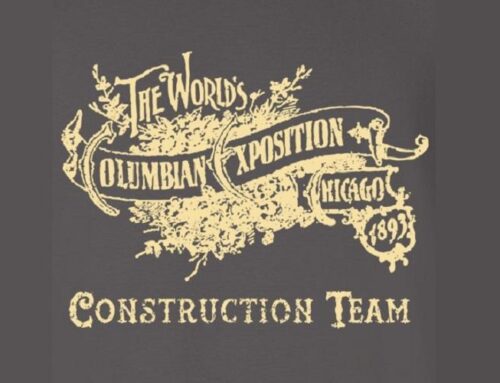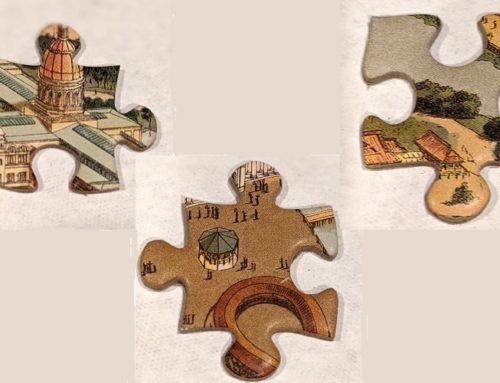The 125th anniversary year of the World’s Columbian Exposition offered scholarship, images, and fiction relating to the World’s Fair in several new publications in 2018.

Pioneers of Promotion: How Press Agents for Buffalo Bill, P. T. Barnum, and the World’s Columbian Exposition Created Modern Marketing by Joe Dobrow. University of Oklahoma Press.
Communications professional and business history writer Joe Dobrow traces the origins of modern American marketing by shining the spotlight on three men: pioneers of promotion John M. Burke of Buffalo Bill’s Wild West show, Tody Hamilton of the Barnum & Bailey Circus, and Moses P. Handy of the World’s Columbian Exposition. Handy and his copious and creative Columbian Exposition publicity materials are the subject of chapters 8 (“The Battle for the World’s Fair”), 9 (“The Department of Publicity and Promotion”), and 10 (“1893”).

The World’s Fair of 1893 – Ultra Massive Photographic Adventure Volume 2 by Mark Bussler. Independently published.
A follow-up to his first volume in 2017, Bussler’s new collection focuses more on the interiors of buildings, crowds and drawings of the Fair with 330 pages of black-and-white images and rare photographs of the Exposition.

Treasured Memories – Columbian Exposition of 1893 by Carol March McLernon. Archway Publishing.
This 34-page softcover children’s book presents a brief history of the Columbian Exposition through color photographs of mementos, advertisements, and objects. McLarnon is also the author of The 1,000-Mile Horse Race: 1893 (Author House, 2018), about a race that began in Nebraska’s panhandle and ended outside the gate of the World’s Fair in Chicago.

Chicago by the Book – 101 Publications that Shaped the City and its Image by the Caxton Club, with an Introduction by Neil Harris. University of Chicago Press.
The venerable Caxton Club bibliophilic society has selected 101 landmark books about Chicago from the past 170 years and noted Chicagoans provide a short essay on each. Titles relating directly and indirectly to the 1893 World’s Columbian Exposition extend though the volume (11 by my count), providing a continuous thread woven through more than 130 years of the city’s history.
Of course, the 2003 international best-seller The Devil in the White City by Erik Larson (#100) is in there. How many millions had their interest in the 1893 World’s Fair sparked by this thrilling non-fiction narrative of murder, magic, and madness? Larson’s engaging prose relies on a wide range of primary works. Neil Harris, author of Grand Illusions: Chicago’s World’s Fair of 1893 (Chicago Historical Society, 1993) provides a summary of the monumental history of the Fair by Rossiter Johnson. His four-volume A History of the World’s Columbian Exposition Held in Chicago in 1893 by the Authority of the Board of Directors (#19), published by D. Appleton and Company in 1896 and 1897, offers a “respectful and even rhapsodic” record of the exposition in its 2,100 pages. “But if its size and detail discourage easy browsing,” Harris advises, “surprises await the hardy explorer.”
Architectural giants who built the Fair are represented in a pair of titles. Frederick Law Olmsted and Calvert Vaux’s 1871 Report Accompanying the Plan for Laying Out the South Park (#6) describes their first design of Jackson Park in the years before the Fair; Daniel Burnham’s 1909 Plan of Chicago (#29) demonstrates its influence on grand plans for the larger city.
Two 1893 publications highlight different aspects of the city serving as a temporary capital of the world. Rand McNally & Co.’s Birds-Eye Views and Guide to Chicago (#14) provides a snapshot of the rapidly emerging inland metropolis, while Henry B. Fuller’s The Cliff-Dweller’s: A Novel (#13), profiles the fictional lives of those populating a downtown skyscraper. An award-winning 2000 graphic novel by Chris Ware, Jimmy Corrigan: The Smartest Kid on Earth (#97), prominently features the White City in its multi-generational story.
The Reason Why the Colored American is Not in the World’s Columbian Exposition: The Afro-American’s Contribution to Columbian Literature (#15) is a small volume that packs a powerful message. Current Cook County Board President (and Chicago mayor hopeful) Toni Preckwinkle offers a thoughtful look at this protest publication by Ida B. Wells, Frederick Douglass, and other activists. Preckwinkle writes that “the demand for the end of racial inequities raised powerfully by Wells and her coauthors continues today.”
The legacy of Chicago’s first fair shows up in A Century of Progress in Exposition Chicago 1933-1934 (#56), Bessie Louise Pierce’s A History of Chicago, Volume 3, the Rise of a Modern City 1897-1893 (#60), Give the Lady What She Wants! The Story of Marshall Field and Company (#75), and William Cronon’s 1991 environmental history Nature’s Metropolis: Chicago and the Great West (#95).

Born Criminal: Matilda Joslyn Gage, Radical Suffragist by Angelica Shirley Carpenter. South Dakota Historical Society Press.
While living with her daughter and son-in-law (the future best-selling children’s author, L. Frank Baum) in Chicago during the summer of 1893, Matilda Joslyn Gage visited the World’s Fair several times. Carpenter’s biography of the suffragist, abolitionist, freethinker, and radical touches upon these visits in the twilight of her remarkable life.

Women in International and Universal Exhibitions, 1876-1937 by Myriam Boussahba-Bravard and Rebecca Rogers. Routledge.
This academic collection includes “Unpretentious Paintings: Mexico’s National School of Fine Arts’ Women Students at the 1893 Chicago Columbian Exposition” by Ursula Tania Estrada, “After Mature Deliberation: Women Lawyers’ Infiltration of the 1893 World Columbian Exposition” by Gwen Jordan, “African American Women’s Voices at the 1893 Chicago World Fair” by Claudine Raynaud, “International Activism After the Fair: New South Wales, Utah, and the 1893 World’s Columbian Exhibition” by James Keating, and “Rendezvous at the Expo: Building a Franco-American Women’s Network, 1889-1893-1900” by Karen Offen.

Expanding Nationalisms at World’s Fairs: Identity, Diversity, and Exchange, 1851-1915 by David Seth Raizman and Ethan Robey. Routledge.
This academic collection includes “A Neoclassical Translation: The Hôôden at the 1893 World’s Columbian Exposition” by Hannah L. Sigur.

The Lake on Fire by Rosellen Brown. Sarabande Books.
This epic narrative begins among 19th century Jewish immigrants on a failing Wisconsin farm. Dazzled by lore of the American dream, Chaya and her strange, brilliant, young brother Asher stow away to Chicago; what they discover there, however, is a Gilded Age as empty a façade as the beautiful Columbian Exposition. (from the publisher’s description.)






Leave A Comment